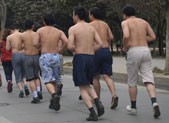
Breath-taking acts
For audiences familiar with shehuo, the most exciting part is xinzi (core), which is the part where children are hung up high from poles, but it looks like they are precariously sitting on top of a pole. In a complicated xinzi, there may be a dozen or so children sitting and standing on top of poles. In formation, they create a three-dimensional shape that moves along seven or eight meters above the crowd of spectators.
According to Wang Zhi, deputy director of intangible cultural heritage protection center at Xi'an People's Art Museum, there are three key factors of a shehuo performance with xinzi: design, makeup and truss.
The design of a mechanism is carefully calculated, taking into account the number of children on the poles and their position (sitting or standing). Other factors that go into the design are the size and experience of the children. Furthermore, the bonds are carefully adjusted; too tight and the child will be uncomfortable, whereas if the bonds are too loose, it could put the child in danger.
"But accidents are rare," said Song Zhirong, because there are too many people walking alongside the children in the parade. Naturally, they are also involved in taking care of the children.
According to the design, performances on the ground can be equally exciting. Yao Bairong, 70, from Hu county in Shaanxi Province started performing shehuo when he was six years old. He specializes in pao zhu ma, which simulates riding a horse in battle. The performer wears a horse made of bamboo and paper on his waist. The performance contains about 30 people, and the formation changes as many as 30 times within one show.
Yao told the Global Times that all his skills and knowledge about shehuo are from his father and grandfather. Maintaining the family tradition, he is now teaching his own grandson.
Development of the art
Shehuo has developed over many hundreds of years. Wang said these days more and more modern agricultural tools such as tractors, trucks, and tricycles are used in the performance. In the old times, creating props was a crucial part of the project. Since the weight of each prop had to be carefully calculated, it could take many performers a whole month to create one with the required weight and shape. Now, they can buy all kinds of tools to shorten the preparation time.
Although, the whole process seems easier today, the importance of shehuo has never been reduced. Song said that a typical shehuo performance could last from 9 am to 6 pm, which makes the children exhausted. But they still love it. "The child who can perform shehuo is usually seen as a clever and pretty child. His or her family will also be proud of their child's performance," he said.
For Wang, the soul of shehuo is teamwork. In one sense, the parade is like a competition, but it's more than that. Neighbors from the same village form teams to see who can put on the most crowd-pleasing performance. Even though there are no judges or prizes, a sense of community and pride motivates each team to do its very best.
Unfortunately, the process of urbanization has pushed some great shehuo performances onto the sidelines of history. Take for example, the once-famous shehuo performance of Dabaiyang village in Shaanxi Province. Since the village was gradually swallowed up by the expansion of Xi'an, it lost the environment and mood for the old-fashioned performances. Although local villagers have still kept the tools and costumes for creating shehuo, they stopped performing years ago.
Still, some villages have hung on to the tradition. If you want to experience it for yourself, check out the Shehuo Art Festival in Hu county, Xi'an. It is held every other year and includes over 1,000 performers - one of the biggest in China. Long county's Shehuo Festival in Baoji, Shaanxi Province, is another choice. You can catch the fun there on February 21-23.

















 Employees run half-naked for not meeting sales quotas
Employees run half-naked for not meeting sales quotas


![]()
